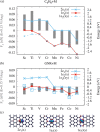Electromigration Forces on Atoms on Graphene Nanoribbons: The Role of Adsorbate-Surface Bonding
- PMID: 38274269
- PMCID: PMC10806770
- DOI: 10.1021/jacsau.3c00622
Electromigration Forces on Atoms on Graphene Nanoribbons: The Role of Adsorbate-Surface Bonding
Abstract
The synthesis of the two-dimensional (2D) material graphene and nanostructures derived from graphene has opened up an interdisciplinary field at the intersection of chemistry, physics, and materials science. In this field, it is an open question whether intuition derived from molecular or extended solid-state systems governs the physical properties of these materials. In this work, we study the electromigration force on atoms on 2D armchair graphene nanoribbons in an electric field using ab initio simulation techniques. Our findings show that the forces are related to the induced charges in the adsorbate-surface bonds rather than only to the induced atomic charges, and the left and right effective bond order can be used to predict the force direction. Focusing in particular on 3d transition metal atoms, we show how a simple model of a metal atom on benzene can explain the forces in an inorganic chemistry picture. This study demonstrates that atom migration on 2D surfaces in electric fields is governed by a picture that is different from the commonly used electrostatic description of a charged particle in an electric field as the underlying bonding and molecular orbital structure become relevant for the definition of electromigration forces. Accordingly extended models including the ligand field of the atoms might provide a better understanding of adsorbate diffusion on surfaces under nonequilibrium conditions.
© 2023 The Authors. Published by American Chemical Society.
Conflict of interest statement
The authors declare no competing financial interest.
Figures






References
-
- Klement P.; Anders D.; Gumbel L.; Bastianello M.; Michel F.; Schormann J.; Elm M. T.; Heiliger C.; Chatterjee S. Surface diffusion control enables tailored-aspect-ratio nanostructures in area-selective atomic layer deposition. ACS Appl. Mater. Interfaces 2021, 13, 19398–19405. 10.1021/acsami.0c22121. - DOI - PubMed
-
- Paul W. Electromagnetic traps for charged and neutral particles. Rev. Mod. Phys. 1990, 62, 531–540. 10.1103/RevModPhys.62.531. - DOI
LinkOut - more resources
Full Text Sources
